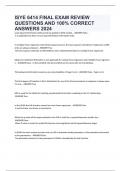Summary
Summary Abstract Literature Learning Processes College 1, 2 and 3 (SOW-OWKM070)
- Course
- Institution
Samenvatting van de literatuur behorende bij college 1, 2 en 3 van Leerprocessen: Farley-Ripple, E., May, H., Karpyn, A., Tilley, K., & McDonough, K. (2018). Rethinking connections between research and practice in education: A conceptual framework. Educational Researcher, 47, 235–245. Howar...
[Show more]













